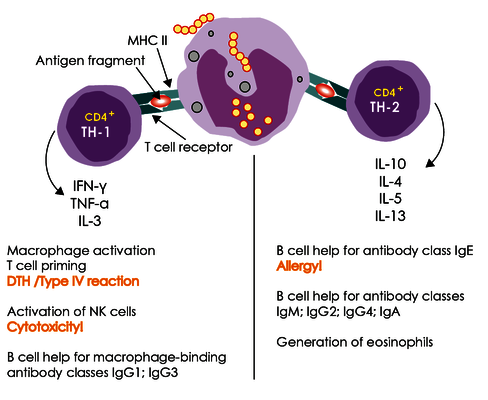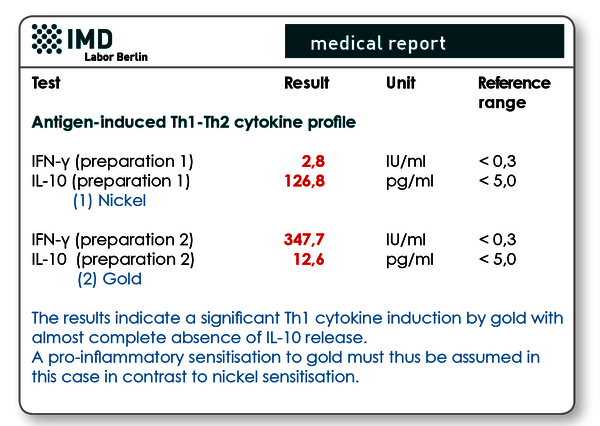

There is a large body of scientific literature available that indicates involvement of cytokines in environmental exposure and diseases as well as allergies. Relevant medical conditions include fibromyalgia syndrome, chronic fatigue syndrome (CFS), multiple chemical sensitivity syndrome (MCS) as well as allergies, silicosis, asbestosis and various neurodegenerative processes. Cytokine patterns are extremely variable due to their kinetics, however, meaning that their measurement in blood only has diagnostic value in exceptional cases. For justified questions, on the other hand, ‘in vitro allergen-induced cytokine secretion’ can make an important contribution to understanding the pathogenesis of an environmental medical condition.
Cytokines are proteins that are secreted by immune cells and other nucleated cells in the body. They trigger specific signals via receptor interactions either in the same cell (autocrine), neighbouring cells (paracrine) or systemically in remote target cells. They are the central regulators of the immune response, initiate every inflammatory reaction and trigger inflammatory-associated symptoms such as fever, swelling and pain. The more than 50 known cytokines include the interleukins (IL-1 to IL-32), the interferons (IFN-α, -β and -γ) as well as various growth hormones (more information can be found on our homepage www.imd-berlin.de under Diagnostic Information / Cytokine Diagnostics).
In particular, classification into pro- and anti-inflammatory cytokines of Th1- and Th2-associated type which are associated with T helper cells is clinically relevant. The Th1 cytokines include interferon-gamma (IFN-γ) and IL-2, TNFα and -β and IL 12. These primarily pro-inflammatory mediators initiate cytotoxic immune responses. Th2 cells, on the other hand, induce humoral responses (antibody synthesis including IgE) via the production of IL-4, IL-5, IL-10 and IL-13 and can counteract the cytotoxic response with ‘tolerance induction’.
Testing for the formation of cytokines by cells of the immune system as part of environment-associated processes is currently of interest. The test of whether particular environmental allergens and substances induce either monocytes/macrophages cytokines, Th1 or Th2 cytokines in an individual case may predict or indicate possible response patterns to these substances. These tests are available in the field of medication allergies but also contact allergies (Sachs 2002, Jakobson 2002, Lindemann 2003). Using nickel sensitisation as an example, several studies have shown that a predominance of IFN-γ synthesis (Th1 dominance) compared to IL-10 is associated with a pro-inflammatory, clinically manifest immune response and that with predominance of IL-10 (Th2 dominance) a tolerogenic response (without a cytotoxic immune response) can often be observed.

A suitable method to characterise the effector mechanisms is in-vitro stimulation of immune cells with the ‘suspected’ allergen/hapten. For this purpose immune cells from the blood of the patient are isolated in specialised laboratories and stimulated with the harmful substances being investigated for a few hours to several days under defined conditions. The cytokines formed are then quantified using highly sensitive methods (ELISA, ELISpot). A positive result indicates an immune response. The pattern of Th1/Th2 cytokines measured may also provide information about the existing effector cell response in light of the clinical situation.
The method answers the following questions for the given indication:
The most important indication in the practice of environmental medicine is based on the fact that the results can indicate the priorities for necessary avoidance of exposure. Because this analysis is very elaborate due to the necessity of monitoring and dilution series as well as expensive cytokine analytics and interpretation is only possible with consideration of the clinical question and other laboratory data, the procedure is reserved for specific diagnostic questions.

Fig. 2 Sample results: Allergen-induced cytokine pattern of a 38-year-old patient with type IV sensitisation to nickel and gold confirmed by LTT and epicutaneous testing.
5 ml heparin blood per to be tested allergen/hapten
Sample receipt within 24 hrs has to be ensured. The sample should be stored and transported at room temperature. Within the Berlin city area, we offer a courier service (+49 (0)30 7701- 250). For collections beyond Berlin, please contact our complimentary courier service (+49 (0)30 77001- 450).
Pleas obtain the costs for the test fron the pdf-document.